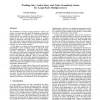Free Online Productivity Tools
i2Speak
i2Symbol
i2OCR
iTex2Img
iWeb2Print
iWeb2Shot
i2Type
iPdf2Split
iPdf2Merge
i2Bopomofo
i2Arabic
i2Style
i2Image
i2PDF
iLatex2Rtf
Sci2ools
ISCA
1993
IEEE
1993
IEEE
Working Sets, Cache Sizes, and Node Granularity Issues for Large-Scale Multiprocessors
The distribution of resources among processors, memory and caches is a crucial question faced by designers of large-scale parallel machines. If a machine is to solve problems with a certain data set size, should it be built with a large number of processors each with a small amount of memory, or a smaller number of processors each with a large amount of memory? How much cache memory should be provided per processor for cost-effectiveness? And how do these decisions change as larger problems are run on larger machines? In this paper, we explore the above questions based on the characteristics of five important classes of large-scale parallel scientific applications. We first show that all the applications have a hierarchy of well-defined per-processor working sets, whose size, performance impact and scaling characteristics can help determine how large different levels of a multiprocessor’s cache hierarchy should be. Then, we use these working sets together with certain other impo...
Related Content
| Added | 08 Aug 2010 |
| Updated | 08 Aug 2010 |
| Type | Conference |
| Year | 1993 |
| Where | ISCA |
| Authors | Edward Rothberg, Jaswinder Pal Singh, Anoop Gupta |
Comments (0)

